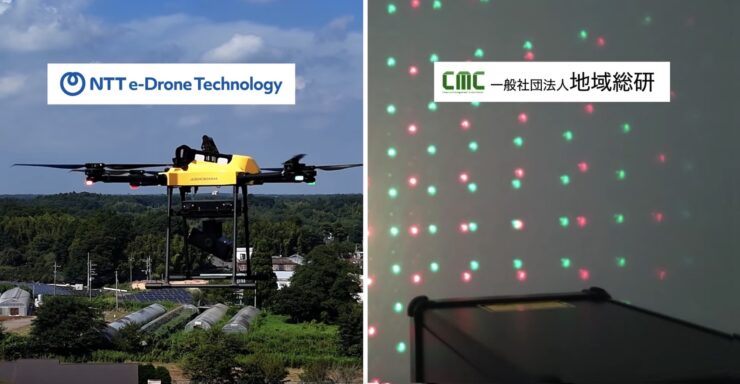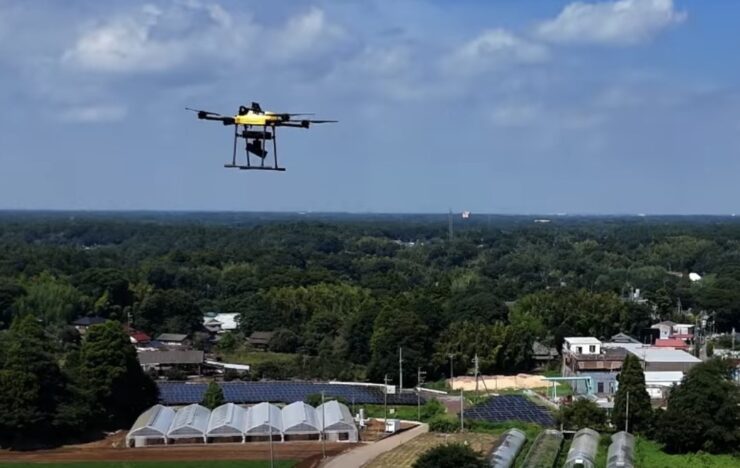
© NTT e-Drone Technology & CMC
Beginning in early 2022, the United States faced one of its worst outbreaks of Highly Pathogenic Avian Influenza (HPAI) in decades. The virus spread rapidly through wild migratory birds and domestic flocks, infecting poultry operations across dozens of states. Bird flu is highly contagious among birds, transmitted through contact with infected droppings, feathers, or surfaces. Once detected in a commercial flock, standard containment protocols require culling entire populations to prevent further spread. By 2023 and into 2024, tens of millions of egg-laying hens were destroyed, causing a sharp drop in supply and driving egg and poultry prices to record highs nationwide. Now, innovative solutions like NTT laser drones are emerging to help stop future outbreaks.
Japan experienced a similar crisis at the start of 2025. HPAI outbreaks struck several regions, forcing large-scale culling to contain the disease. Like in the U.S., this sudden supply shock led to price increases and highlighted the vulnerability of poultry sectors to avian influenza disruptions. In a recent press release announcing a possible solution, NTT stated, “Between January and February 2025, a severe situation unfolded within Chiba Prefecture, resulting in the culling of over 3.3 million poultry.”
Combining NTT Laser Drones, AI, and Communication Networks
Founded in 2020, NTT e-Drone Technology is a subsidiary of NTT East based in Tokyo, Japan. Its mission is to combine drone innovation with advanced communication networks and AI to address agricultural, environmental, and infrastructure challenges across Japan. NTT focuses on practical drone solutions that can be deployed quickly by municipalities and private operators to solve pressing issues ranging from crop spraying to disaster response.

NTT supplies a mix of its own drones and models from major international manufacturers such as Skydio and Parrot. Its flagship AC102 is a lightweight agricultural drone developed in-house, tailored to Japan’s unique farm landscapes. Through partnerships with Skydio and Parrot, the company also distributes autonomous aircraft designed for inspection, mapping, and emergency missions. In response to how HPAI has influenced the poultry industry, NTT laser drones were introduced as a high-tech solution to help farmers deter wild birds.
Laser Drones Protecting Poultry From Wild Birds
Wild birds are major spreaders of HPAI, and large flocks foraging near farms increase the risk of infection. Traditional deterrents such as nets, noisemakers, or stationary lasers often have limited effectiveness, as birds adapt to them over time. To counter this, NTT has begun deploying specialized drones equipped with laser systems that can actively patrol farm perimeters and scare away birds before they approach poultry facilities.
“The goal is to create a moving deterrent barrier that is far more adaptable than stationary devices, reducing the likelihood of repeated bird visits and minimizing opportunities for disease transmission,” NTT stated in its announcement.
The NTT laser drones system was tested over the past year at multiple farms in Chiba Prefecture. The drones fly preset routes, using onboard sensors to detect birds in the area. Once a flock is detected, the system projects a laser pattern that disrupts their flight paths, prompting them to leave the vicinity. According to field reports, the laser deterrent has proven effective against a wide range of species without harming the animals.
Expanding Biosecurity and Sustainable Agriculture
The technology is part of a broader national push to strengthen biosecurity measures in Japan’s poultry sector. Drones offer a flexible platform that can cover large areas quickly and be programmed for daily autonomous patrols. Because they can be repositioned as conditions change, they also provide farmers with a tool that adapts to shifting migration patterns and seasonal risks. Similar systems have been explored in the Netherlands and parts of the United States to deter geese, starlings, and other nuisance birds from crop fields and livestock areas.
NTT has found that this approach has the potential to reduce reliance on chemicals or lethal control methods, offering a more sustainable way to protect livestock health. The NTT laser drones program has been shown to go beyond deterring birds as well. Farms and infrastructure sites in rural Japan often face challenges from deer, boar, and other animals that can damage crops or disrupt operations. By integrating AI detection and autonomous flight, drones could eventually provide continuous monitoring and response without requiring human operators to be on site.
As Japan continues to rebuild its poultry sector after the devastating HPAI losses, technologies like NTT laser drones are likely to play an increasingly important role. By creating a dynamic, non-invasive barrier against wild birds, these systems aim to reduce the risk of future outbreaks while keeping production costs under control. In the United States, where wild bird migration has played a major role in spreading avian influenza, drone deterrent technologies could complement existing biosecurity measures and help prevent the kind of supply shocks that recently drove egg and poultry prices to record highs.
|